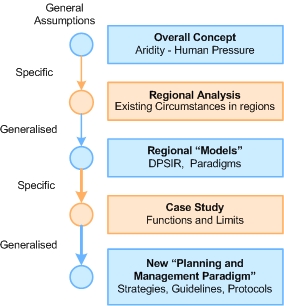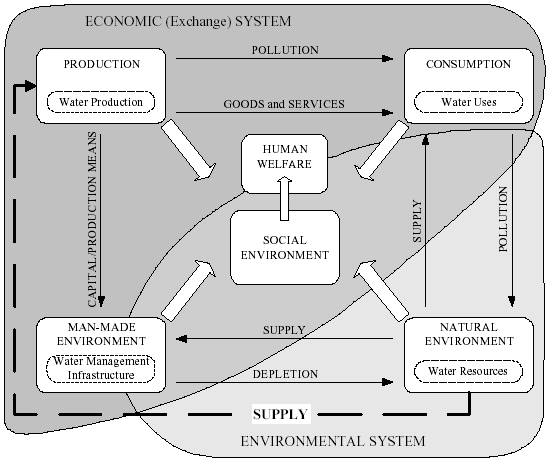The adopted research approach is based on the successive generalization resulting from systematic analysis of specific conditions. The analysis alternates between the generalized and the specific element (Figure 1). On the basis of a generalised concept for aridity, the analysis of specific regions tried to provide "lessons" that were used to develop Regional Models, to be further analyzed through the Case Studies.

Figure 1. Project Logic
The Case Studies are expected to yield results that can be used for a broad spectrum of similar regions, in the form of Strategies for Integrated Water Resources Management, Guidelines and Protocols of their Implementation.
The central idea of the project recognises that the existing framework of water management infrastructures, natural environment, water supply (production) and consumption, institutional and socioeconomic conditions is the main factor in determining the appropriate strategies that may direct to improved water resources management. The interactions among the main components of the socioeconomic and environmental systems (Figure 2) determine the decisive issues that the project will analyse.

Figure 2. Water resources management framework
The initial step of the overall project methodology is based on this recognition and focuses on the definition and modelling of a coherent typology of water deficient regions by outlining the basic differences and similarities on key issues related to water resources management. The selection of representative case studies, as specific paradigms, provides the required step for a detailed study of the interrelation of water production and consumption system and the man-made and natural environment and will highlight the specific water problems of arid and semi-arid regions. A multi-criteria methodology for coping with watermanagement decisions will integrate available models and tools into a decision-making approach for selecting appropriate strategies for each paradigm. The synthesis of the results from the paradigms analysis will conclude to general guidelines and protocols for improved water management practices in water deficient regions. The development of water cost recovery strategies for improved resources management should encompass scientific information related to the water system dynamics and stakeholder requirements related to the interactions of economic, social and environmental systems. Such strategies should be based on the detailed evaluation of direct and indirect costs of water use, the estimation of appropriate water prices and the comparison of alternative water management scenarios through an integrated multi-criteria approach.
In this regard, the following premises characterise the Project methodology:
-
Application of holistic policy analysis that enables decision makers to coordinate various governing authorities, delineate and assess a wider range of alternatives, and finally select and implement relevant water pricing plans.
-
Development of a methodology, which based on the above analysis, may make possible the application of an integrated management approach that should primarily focus on the identification of sustainable alternatives for water cost recovery according to anticipatory planning, on providing control and alarm criteria and finally on implementation strategies of significant value for the stakeholders.
-
Usage of the information technology in the form of a decision support tool, as an integral part of the pertinent methodology and through which improvement in decision-making may occur in analysing quantitative and qualitative impacts in describing the entire gamut of potential responses and in suggesting appropriate solutions.
Top